Around this time last year I did a post on Begonias. It was getting to the end of a growing season during which I’d been experimenting further with planting out some supposedly hardy begonias as well as some that I knew would need lifting again before the winter. I have repeated and extended my experimentation this season and with cold weather upon us, it seems a good time to bring the story up to date.
Begonia grandis subsp. evansiana has been grown as a hardy plant for many years and is the first one that I tried in the garden. I have a pink and a white flowered form, equating I believe to the straight species and var alba, as listed on the RHS website. They have seven other forms listed, none widely available, if at all. I have tiny plantlets of another form, B. grandis ‘Nanjiang Silver’, and have recently acquired ‘Torsa’, a particularly robust hybrid form.

The groups of pink and white that I have in the garden grew at least two feet tall last year, died down for the winter and are now back up to two feet again. The plants weren’t cut down by frost but collapsed and broke off from the roots in late autumn. They produce bulbils in their leaf axils, often about grain of wheat size but sometimes twice that or more. The bulbils I received of ‘Nanjiang Silver’ were barely 2mm long and I’m impressed that they survived and grew at all.
They are growing in the shade of an oak tree and the bulbils fell amongst the fallen leaves where they lay all winter. They seem happy to lie dormant until about May or June, not drying out, rotting or being eaten by slugs, then they start into growth again. I think what I have now is a mix of growth from bulbils and the roots of last year’s plants.

I collected bulbils and overwintered some planted like miniature bulbs in pots of compost with their tips just showing. Most but not all survived. Others I kept moist in ziploc bags until planting them in the same way in spring. All of them survived.
Begonia sutherlandii is another species which behaves in similar fashion, producing numerous bulbils and growing in spring both from them and the old rootstock. We have had a pot of B. sutherlandii survive outdoors for three or four winters but this year I potted up and grew on some of the bulbils, planting them out in June or July from 9cm pots. They have done well and are flowering nicely. I will leave them in the ground and see if they survive.
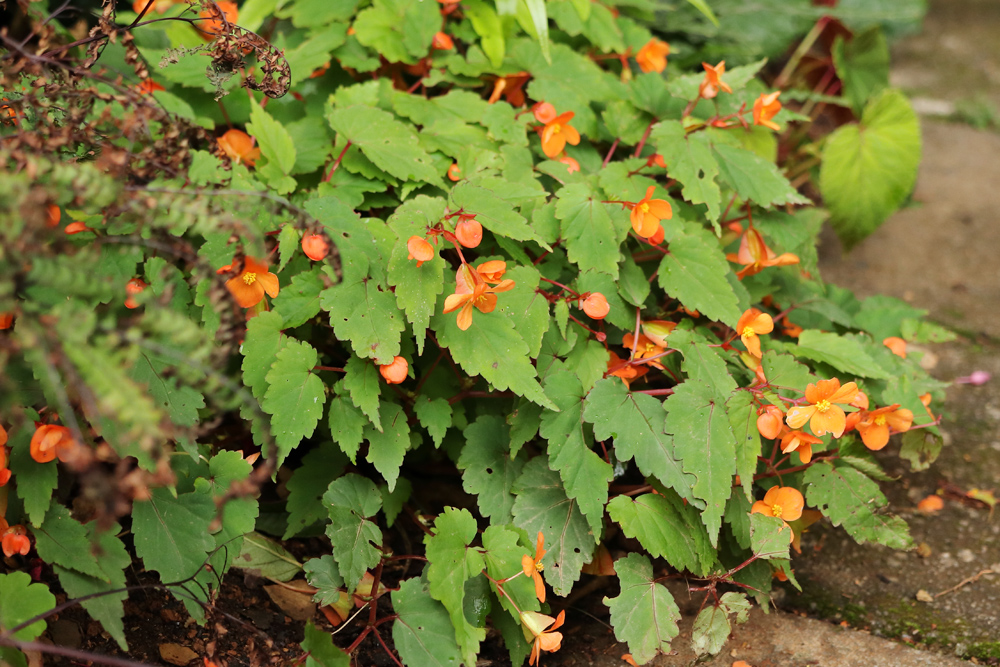
Begonia grandis is usually sold as being hardy; B. sutherlandii not, to my knowledge. I am not really sure about either, in that with a tree canopy overhead and a couple of inches of leaves overlying them on the ground, they are not likely to have been subjected to freezing temperatures at all. What I can say is that if new plants are raised from bulbils and overwintered under cover in 9cm pots, they will have a head start of two months or more over the plants left in the ground, a difference that really matters when they tend to make a late start anyway.
The other Begonias that I have grown in the ground have not produced bulbils, so that avenue to propagation and overwintering is closed. The choice is simply to leave them in or lift them and bring them under protection.
Begonia sikkimensis coll. Michael Wickenden. At least that’s the identity it came to me with. It seems to be a new species with no name, just the collection number U614. I grew this in a pot for a few years and it didn’t really thrive so I planted it in the ground. In its first winter it nearly died, emerging very late the following year. I dug it up and overwintered it under cover last winter, then planted it out in spring once it was well into growth. It has been superb this year. I must have missed a bit when I dug it up as it has reappeared there but isn’t doing very well. I have taken a few stem cuttings of it and they took readily enough. It is wholly deciduous, so given a covering of leaves it is easily protected from frost, so perhaps it is the coldness of the ground in spring that stops it getting going until June or July. I will let both plants die down before lifting them, or perhaps cut them down if they’re still standing next month.

Begonia ‘Garden Angel Blush’ has behaved in exactly the same way, planted out from new, only just surviving the winter and coming into growth very late. Overwintered under cover the second year it has been much better this year, having been planted back out in May. It is well worth a bit of extra effort, having exceptionally beautiful foliage and bright scarlet flowers. I probably had in slightly too much shade as it’s become a little leggy. Again, I will lift and pot it sometime this month and it will lose or have its top growth removed. It can then get shoved under a bench somewhere until spring, kept nearly dry.

Another variety I have had for a number of years is just labelled Begonia ‘Wavy Green’. It came from Barracott Plants and they, like everyone else, tell you it came from the high Himalayas and little else. Having got a young plant well established I left the parent plant outdoors last winter, still in its pot. It survived, just, but didn’t green up until June. It produces a mat of near prostrate stems with rather ordinary green leaves and has managed to produce an occasional white flower. In short, it appears barely worth growing but it’s a newly introduced, unidentified species from somewhere with an unpronounceable name so I have to keep it. I planted the parent plant in the ground around July and it’s looking a lot better for it. I have the younger plant as backup and will leave the older one where it is.

Begonia luxurians is certainly not hardy and will be killed to the ground by the first significant frost. It will not regrow. Nevertheless, it is easily propagated and will overwinter satisfactorily with very little heat, just kept frost free. Planted out in the garden after being confined to a pot for a couple of years, it really took off. I planted two last year, from 3L pots. I lifted one well before it was at risk of frost and potted it into a 7.5L pot. The other I intended to leave to its fate but relented when it got to January and was still looking passable. Both were planted out again in May this year and are growing very happily. The plan is to lift and pot them for the winter but I do have several young plants and the old ones will need a lot of room.
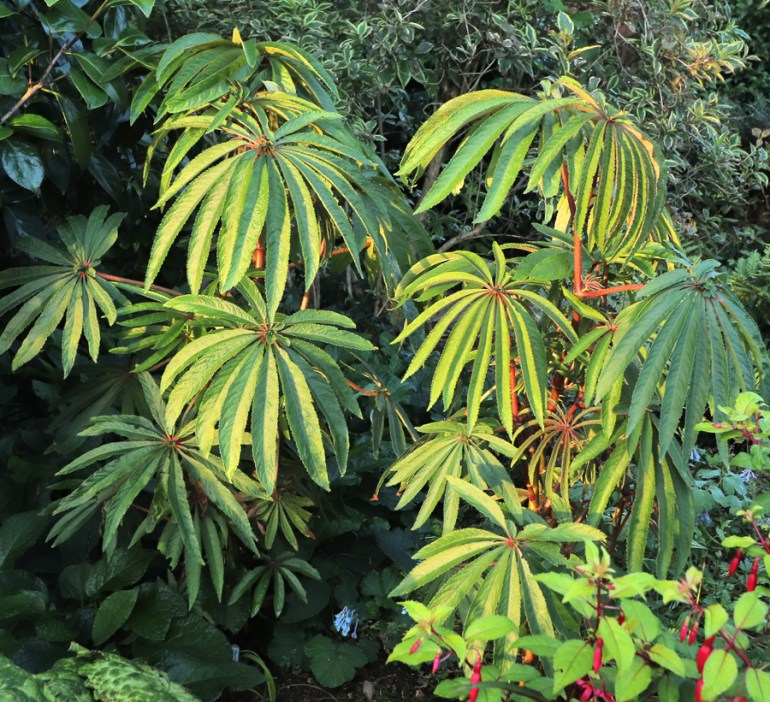
Begonia ‘Tie Dye’ is another Michael Wickenden collection and really is a most impressive plant. Grow Wild nursery say it is not hardy and I won’t leave it outside for the winter but I have a couple of cuttings going so I will try planting it in the ground at some point. I plunged my original plant, in its pot, outside in a shady place for this summer and it has done very well, especially considering that it is pretty pot bound in its 7.5L pot. It has now been brought back under cover for the winter. I may pot it on in spring and plunge the pot again. It makes it easy to bring in for winter but I could do with a winter/spring subject to replace it.
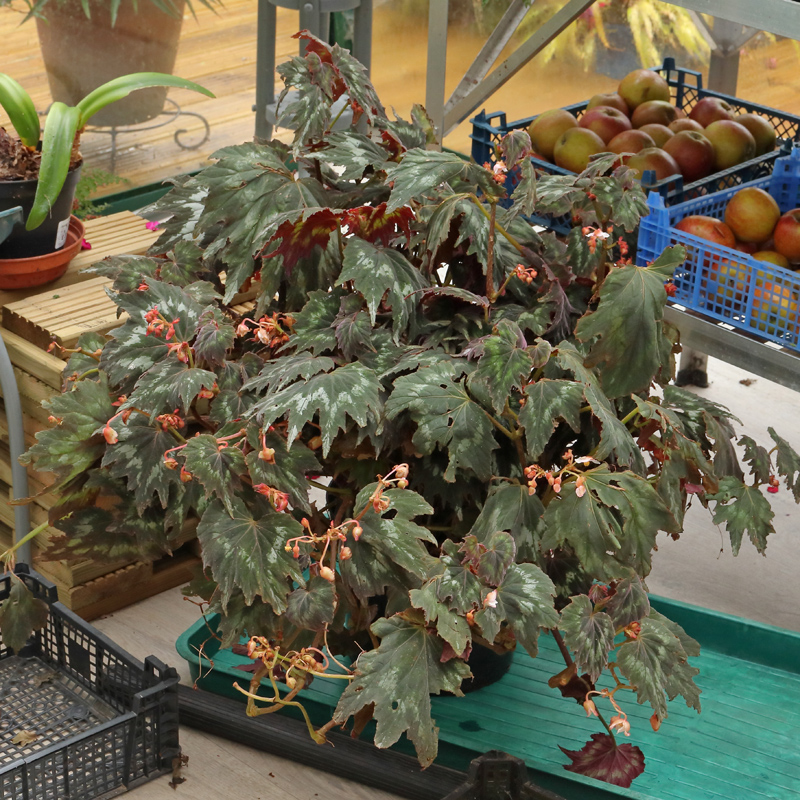
At the same time that I plunged ‘Tie Dye’, I did the same with Begonia ‘Snowcap’. This is a quite tall growing cane type begonia with big, boldly spotted leaves and profuse red flowers. Like ‘Tie Dye’, it should have been potted on before being plunged, but it did pretty well anyway, needing a bit more feeding and watering than it might have and not looking at all out of place in my shady corner.

Begonias are widely planted as bedding plants and there is nothing more garish than a bed filled with different coloured bedding begonias. There are so many of them though, some with vivid coloured flowers, some in subtle paler shades, some with dark foliage, weeping varieties and so on. None are hardy and no-one pretends they are. They are however great garden plants and pretty easy to grow. There doesn’t seem to be much reason to think that a lot of the other species and varieties, primarily regarded as foliage house or conservatory plants, wouldn’t do just as well or better planted in the garden for the summer.
I’m constantly experimenting with different plants so trying out various Begonias suits me well. I’m not much bothered by the debate about whether they are hardy or not; it seems to me that even if they are they will mostly perform much better if treated as not. There are parallels with Dahlias here, though slugs might be marginally less of an issue.
Good foliage plants are of high value in the garden and Begonias manage, often with leaves alone, to pull off the trick that Rhododendrons have perfected, of producing a mass of colour without losing their air of refinement. In the conservatory we have a considerable number of begonias, some we have had several years, most I have bought in the last year or so. One was explicitly sold to me as hardy, some have been displayed amongst other hardy plants with nothing to say they are not hardy, or indeed that they are. Some have been bought as summer bedding plants. My intention is to propagate some backups then treat most of them as summer bedding, probably with a focus on providing interest where spring flowerers have finished and probably mostly in full or part shade.
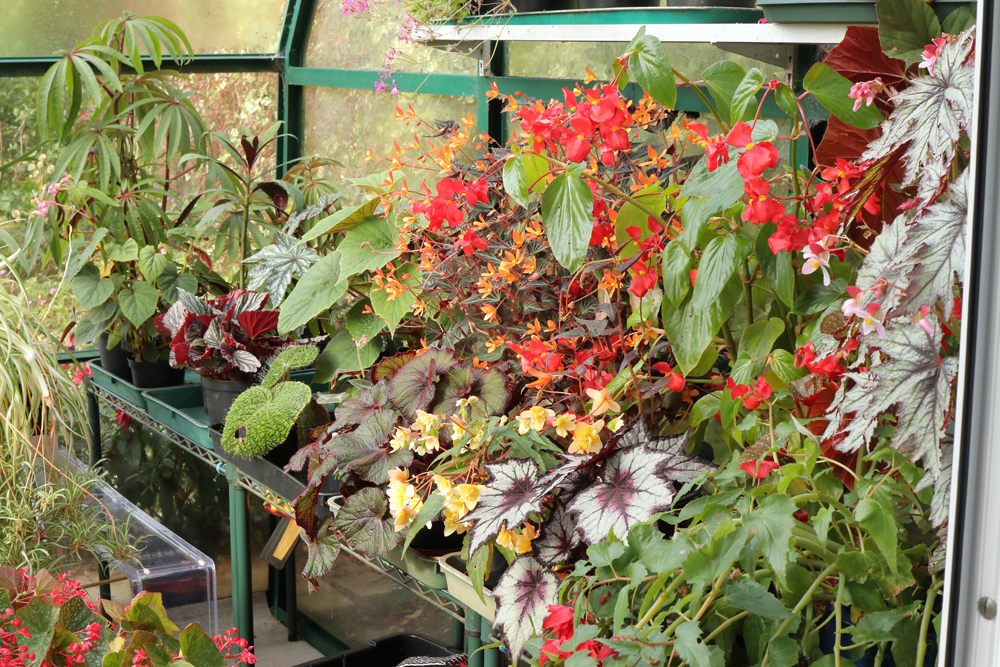
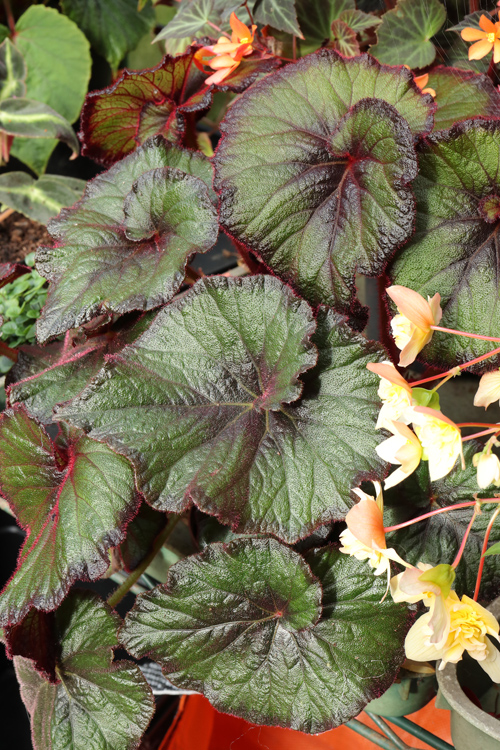

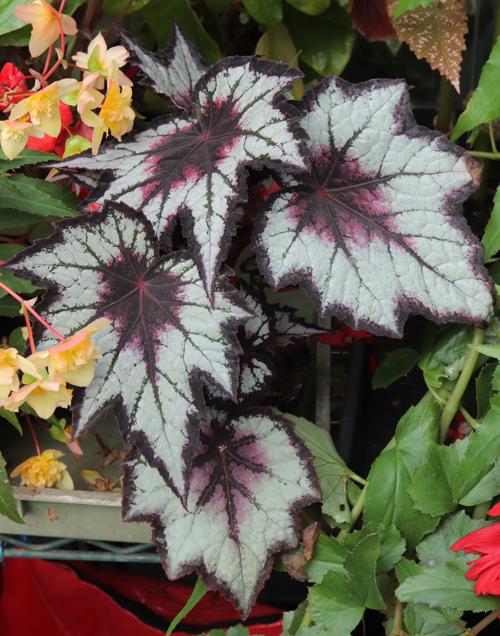

front row: B. ‘Mishmi Silver’, B. sizemoreae, B. listada
There are a few nurseries that I have come across that are championing them, for example:
Pan Global Plants
Growild Nursery
Dibleys Nursery
Crûg Farm Plants
Barracott Plants
Sadly I hadn’t taken my camera. I thought of you when I was admiring them. The planting would have graced Kew Gardens: Bananas, gingers, alstromerias, begonias, and much more, the ones by the church in particular were so tightly packed with wonderful plants. I hope they end up being looked after and reused next year, or sent to ‘good homes’.
LikeLike
Sounds like a must visit if I’m ever up that way.
LikeLike
Great to see your collection, and your description of how they fared and how you have looked after them. I had to be in Yeovil for a couple of hours last week. In their beds and in tubs, they used some of the beautiful leaved begonias to great effect. I even sent an email to the garden team via the Council to congratulate them on the planning, choice of plants, and maintenance.
LikeLike
Good to hear that there’s still a bit of creativity in public planting, did you get any pictures?
LikeLike
I read last years blog with interest but chickened out of planting some of my Begonias outdoors. I divided some of my indoor Begonias this year to reduce their size but then couldn’t bear to throw the ‘spare’ pieces away. They’ve grown well under the staging in the glasshouse and are definitely going to go outside next year.
LikeLike
You’ll never look back.
LikeLike
What an eye-opener! I have dismissed begonias for years, but there are some interesting beauties here. Thx
LikeLike
Someone brought a large, well grown plant of Begonia sizemoreae to the Rhodo, Camellia and Magnolia group AGM last year. Believe me, the reaction was WOW, not oh a Begonia, duh!
LikeLike
That is such a wildly variably genus!
The Begonia Festival used to be an annual event in Capitola. I can not remember when it was cancelled, but it was many years ago. Antonelli’s was a begonia grower as long as anyone can remember. Their retail nursery was something of a tourist attraction. My parents went there several times in the late 1960s and early 1970s.Of course, the region has been redeveloped.
LikeLike
The discovery of hardy and nearly hardy forms (in UK conditions) has bolstered the plant aficionado end of the genus and left the other end looking more brash/vulgar/naff than ever. Needless to say, I grow both. If a plant’s out of fashion, I want to grow it. A nursery growing only begonias would be a little slice of heaven to me.
LikeLiked by 1 person
Oh, it was! Unfortunately, the land is too valuable.
That is rad that you grow plants that are out of fashion. So many are obligated to keep up with fashions.
LikeLiked by 1 person
Your begonias are fantastic. I love it that one has an unpronounceable name, so you have to keep it. I would never have guessed that I would find the best humor in a gardening blog!
LikeLike
I can be very inventive when justifying not getting rid of things. I’m a bit of a hoarder, and not just of plants.
LikeLike
A true confession! I suspect almost everyone hoards some things.
LikeLiked by 1 person